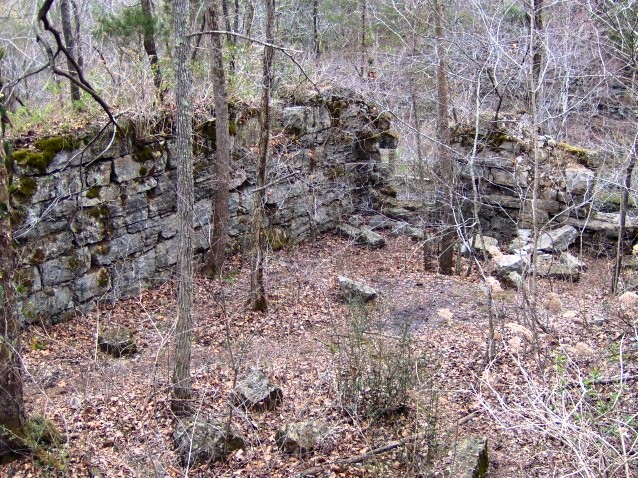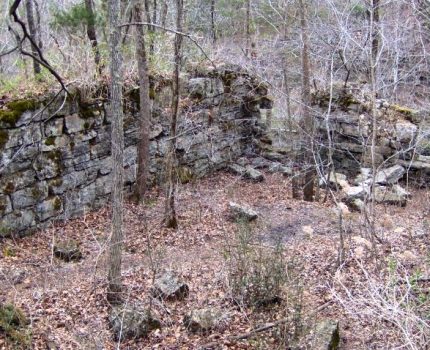Who Made this Mysterious Fort?
by John Davis

Early settlers moving across the Appalachian Mountains from our eastern coastal colonies couldn’t imagine what they encountered. In the thickly forested, astoundingly beautiful region which later became eastern Tennessee, they discovered a stone walled ‘fort’.
Here, at the confluence of two rivers replete with calming and bright waterfalls, was a defensive position created by, well, no one really knew. For some two hundred more years, white men would discuss, debate, and challenge one another’s historical wisdom over what became known as The Old Stone Fort. Oddly, no one consulted the local Native Americans.
Any number of speculations arose to explain this phenomenon. Here was a poorly mounted pile of stones, reinforced by dirt and rubble, which formed a circle. Some 1200 feet long on each side, the fort seemed oddly out of place for a variety of reasons. It wasn’t really high enough for defense, but then it was circular, using the natural ‘defenses’ of the rivers to further protect those within. Of course, true archaeology had not been applied in those early years. Instead, the early settlers’ favorite topic became inquiries about who built this oddly monumental design.
Ideas were plentiful. Some believed that DeSoto, the lost Spanish conquistador known to have traveled the American southwest, was the obvious choice. Others thought unidentified ‘Buccaneers’ were the builders, although nothing supported their presence. Only an imagined ‘shipwreck’ some hundreds of miles fueled this long held belief. Still others speculated that Welshmen, bereft of transport after finding themselves washed ashore in southern Florida, made their way here and defended themselves against the natives. Yet more believed the Vikings made it to eastern Tennessee, because after all Viking village ruins in Canada showed they made it that far. No one imagined the locals could have done it. And they would have been, in a sense, correct.
Indeed, the Native Americans who lived in the area may have been descendants of the original builders, but they had not built Old Stone Fort. No, a University of Tennessee proper archeological dig in 1966 showed that the building was far, far earlier. Ancient peoples from the so-called Middle Woodland period are believed to have constructed the walls. They dwelt in the region from the first millennium until about 430 AD. Their skills were uniquely applied, too. The fort was built over many, in fact hundreds of years. We now know it was not even a fort at all.
It had some ceremonial purpose. Nothing of note, no artifacts, no other buildings, no burials, no weapons were ever found within the 400 acre site. Only the walls existed, and they tell the story.
An opening in the present mound like wall structures was always there. This entry corresponds to the presence of the sun’s rising at the solstice. In short, The Old Stone Fort is really a sort of Stonehenge. Other, similar constructs exist from this period, but are not stone based. Archaeology is a remarkable science, and even today is making the story clearer.
The mysteries yet to be discovered are displayed at an excellent small museum on the grounds. Informed guides take you on a tour of the walls, showing not only the ancient presence, but the later built ruins of a nineteenth century grain and powder mill. You’ll not only find major mysteries to satisfy your visit, but you’ll enjoy seeing a place where one German guest was overheard to say, “I think we have found paradise.”
~ Article by John Davis
Read More from John

John William Davis is a retired US Army counterintelligence officer and linguist. As a linguist, Mr. Davis learned five languages, the better to serve in his counterintelligence jobs during some 14 years overseas. He served in West Germany, Italy, and the Netherlands during the Cold War. There he was active in investigations directed against the Communist espionage services of the Soviet Union and Warsaw Pact. His mission was also to investigate terrorists such as the Red Army Faction in Germany, the Red Brigades in Italy, and the Combatant Communist Cells (in Belgium) among a host of others.
His work during the Cold War and the bitter aftermath led him to write Rainy Street Stories, ‘Reflections on Secret Wars, Terrorism, and Espionage’ . He wanted to talk about not only the events themselves, but also the moral and human aspects of the secret world as well.

And now recently published in 2018, John continued his writing with Around the Corner: Reflections on American Wars, Violence, Terrorism, and Hope.
Two powerful books worth reading.
Read more about them in the following Six Questions:
Six Questions with John Davis: Author of Rainy Street Stories
Six Questions with John Davis: Author of Around the Corner
.
.
.

